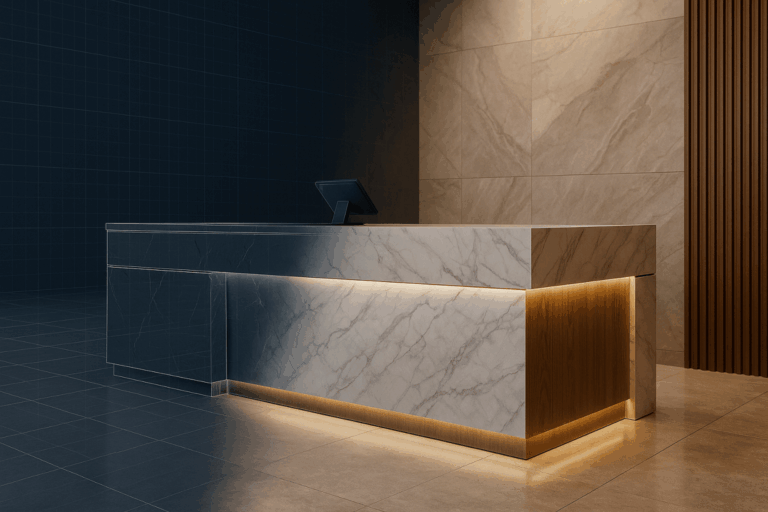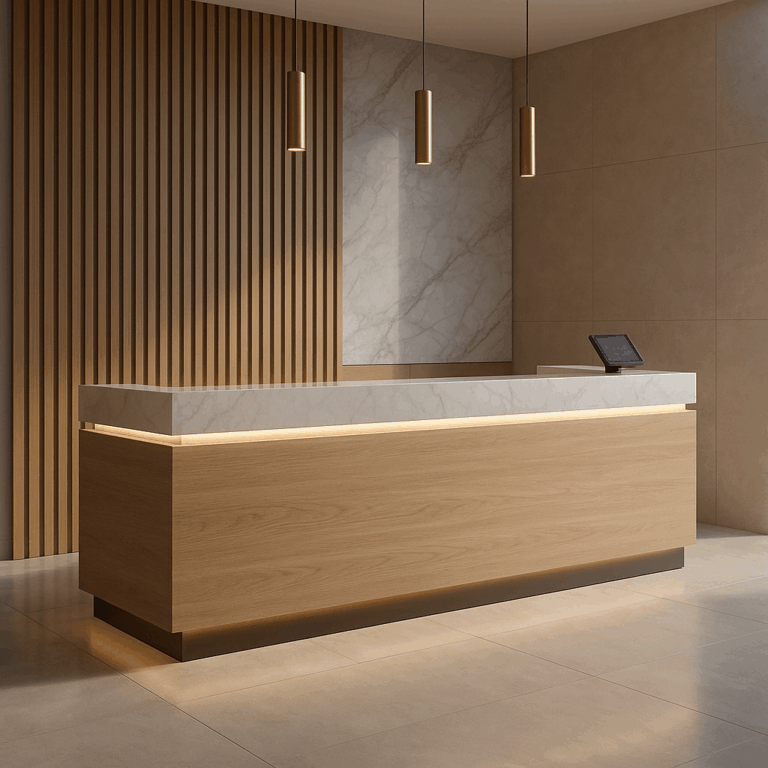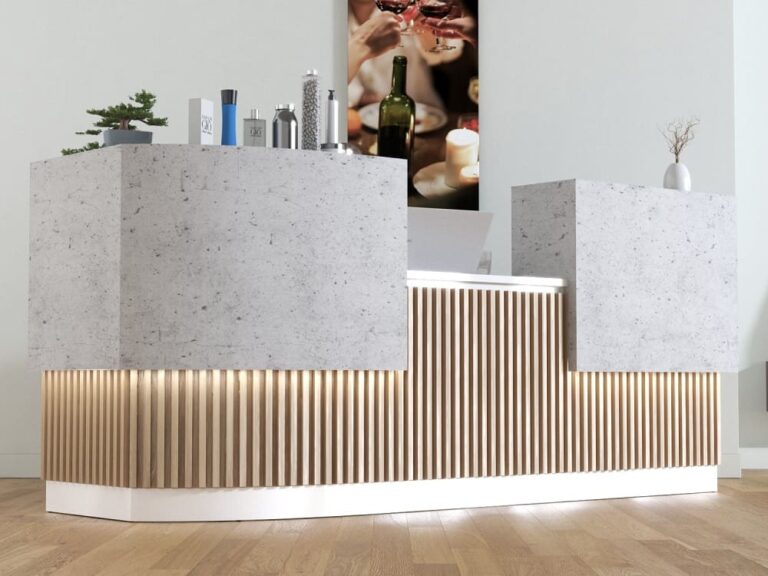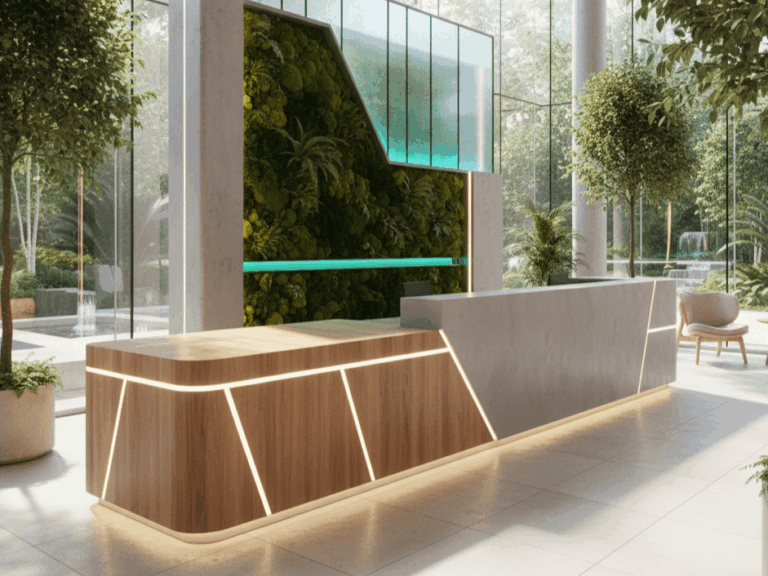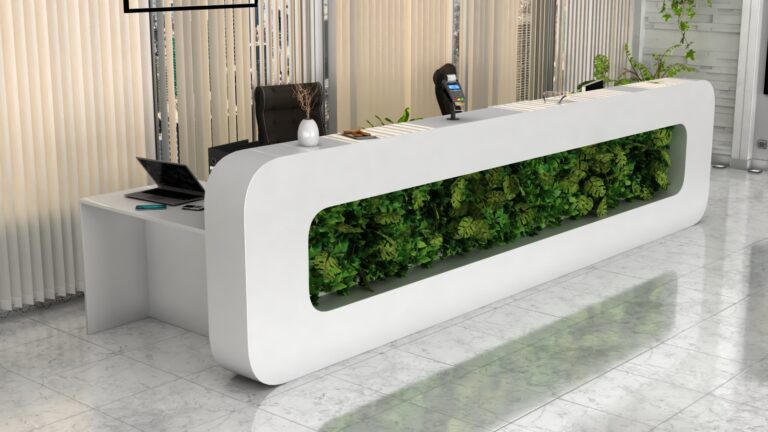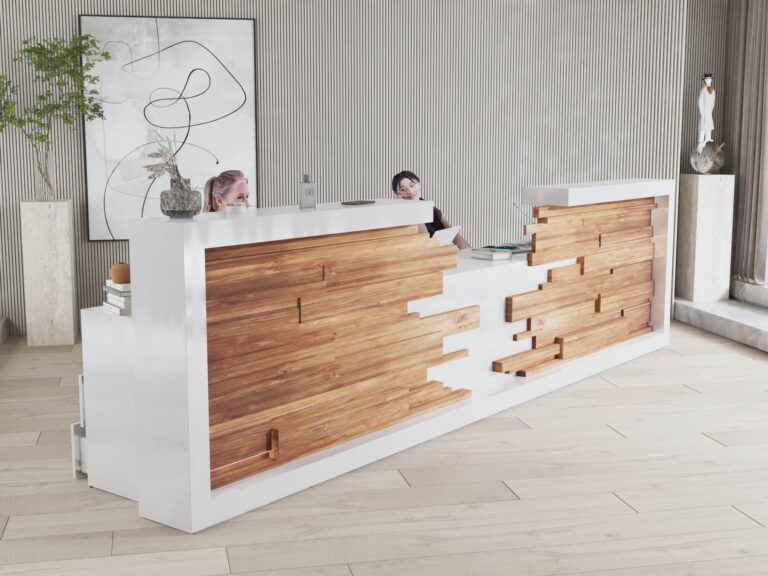When someone steps into a reception area, they’re experiencing more than just a waiting room – they’re getting a first taste of an organization’s character. Reception spaces shape perceptions, influence mood, and set the tone for the experience to follow. In fact, a well-designed reception area can “give visitors a positive first impression and send the right message about your company” – it even “should set the tone for the work day” for employees who pass through it
At Welkomst, we recognize this profound impact. “A meticulously designed reception area is an introduction that sets the tone for what lies beyond,” as our design philosophy states.
That’s why Welkomst is committed to crafting reception desks and entry spaces that enhance first impressions and create a genuinely welcoming atmosphere from the moment someone walks in.
The Power of First Impressions
Psychology tells us that first impressions form in a matter of seconds (or less). You never get a second chance at it – experiments at Princeton University found that people form opinions of a stranger within a tenth of a second of seeing their face
In a reception area, visitors are likewise “thin slicing” the environment and making snap judgments about your business almost instantly. Environmental cues in those first few moments have a powerful influence on how professional, trustworthy, or high-quality your brand appears.
Seemingly minor details can sway these split-second perceptions. For example, cleanliness and order in a space signal professionalism – one study showed that participants who entered a neat, uncluttered office rated its owner as far more conscientious and agreeable than when the office was messy
In other words, if your reception area is disorganized or cluttered, visitors may subconsciously question your company’s diligence or care. Similarly, design elements and layout send messages: research on office reception spaces found that certain physical features convey either a warm, welcoming vibe or a more formal, rigid tone.
Abundant comfortable seating, plants, and artwork can communicate “warmth, comfort, ease, and goodness of communication,” whereas sparse furnishings or imposing barriers signal “order [and] rigidity”
Notably, people in that study said they’d prefer to work for companies whose reception areas felt more warm and considerate rather than cold and controlling – proof that first impressions can even influence long-term affinity.
Even very subtle design choices make a difference. One fascinating experiment found that the shapes used in decor and furniture affect how visitors feel about a company. Angular designs (think sharp-edged desks or square lighting fixtures) tended to suggest competence and efficiency to customers, while rounded, curved shapes conveyed friendliness and warmth
In fact, in that study, when a waiting area was busy, people were more satisfied if the space featured angular, businesslike elements – presumably because it implied professionalism under pressure. By contrast, in a calmer setting, curvy and circular forms made people happier, as they signaled a friendly, hospitable environment
Lighting and materials work similarly: soft, warm lighting might make guests feel relaxed, whereas harsh fluorescent lights or cheap-looking materials could send the wrong signal. All these environmental cues coalesce in those first few seconds to create a snap judgment about your organization’s professionalism, trustworthiness, and quality. A reception space that feels thoughtfully designed and aligned with your brand’s values will inspire confidence from the get-go.
The Role of Spatial Design in Human Psychology
Reception design isn’t just about aesthetics – it’s rooted in environmental psychology, which examines how our surroundings affect our emotions and behavior. Spatial design can subtly influence how welcome, relaxed, or stimulated people feel. A few core design principles illustrate this connection between space and psyche:
- Biophilic Design (Bringing Nature Indoors): Humans have an innate affinity for nature, so incorporating natural elements into a reception area can dramatically improve mood and comfort. Introducing greenery – like potted plants, living walls, or even natural wood and stone textures – helps create a calming, restorative atmosphere. Studies show that adding such biophilic elements literally lowers stress levels; for instance, indoor green walls have been found to reduce blood pressure and stress, and even alleviate symptoms of depression in occupants. Even simple touches like a vase of fresh flowers or a view of greenery through a window can evoke feelings of calm and relaxation, making visitors feel at ease. In a reception context, a splash of nature doesn’t just beautify the space – it sends a subconscious message of health, freshness, and care that guests will pick up on instinctively.
- Color Psychology: Colors are proven to have a profound impact on our emotions. The palette you choose for walls, seating, and décor in a reception area can set a definitive mood. Warm colors like reds, oranges, or yellows tend to energize and draw attention – they can create a sense of excitement or urgency (imagine a vibrant tech startup lobby with bold accents). In contrast, cool colors such as blues and greens are known to promote relaxation and tranquility. Blue in particular is often associated with calm, trust, and professionalism, which is why deeper blues are popular in corporate reception designs aiming to instill confidence. Meanwhile, soft neutrals and earth tones can convey stability and comfort (think of a spa or hotel reception done in gentle beiges or greens to soothe anxious travelers). It’s important to note context as well – a pop of bright color can liven up a space, but too much can overwhelm. Effective reception design uses color strategically to reinforce the emotional tone you want visitors to feel, whether that’s energized, welcomed, or reassured.
- Open vs. Enclosed Spaces: The layout and openness of a reception area also influence how people respond to it. Open, airy layouts with plenty of space to move will foster a sense of freedom and can encourage social interaction among visitors. In fact, architects note that open floor plans tend to promote a feeling of connectivity and ease, helping people feel free to circulate and engage with the environment. This is great for high-traffic lobbies or co-working spaces where a buzz of activity is welcome. On the other hand, more enclosed or sectioned-off areas can evoke feelings of intimacy, privacy, and security. A reception that includes a cozy nook with a few chairs, for example, might make a nervous client feel safer and insulated from chaos. It’s a careful balance – too closed-off, and a space can feel cramped or unwelcoming, but a thoughtfully placed partition or a lower ceiling in one zone can add warmth. The key is aligning the spatial layout with the desired mood: do you want your guests to feel the grandeur of an open atrium, the comfort of a quiet corner, or a mix of both? Understanding how spatial configuration affects human psychology allows designers to shape reception areas that elicit the right behaviors – be it lively conversation at a networking event or calm focus in a clinic waiting room.
By leveraging these principles of spatial design – integrating nature, using color with purpose, and balancing open versus intimate spaces – a reception area can subtly guide the emotions and behaviors of everyone who enters. The result is an environment that isn’t just seen, but felt in a positive way.
The Science of Comfort and Welcoming Environments
A truly welcoming reception doesn’t just look good; it feels good on a sensory and human level. There is real science behind making guests comfortable and reducing any anxiety they may have while waiting. Key factors include lighting, acoustics (sound), and furniture comfort – each of which can be tuned to put visitors at ease:
- Lighting: Light has a direct impact on mood and stress. Bright, natural light during the day can boost alertness and positivity, but harsh or overly intense lighting can cause discomfort. The goal in a reception space is to provide soft, well-balanced lighting that avoids both dim gloom and blinding glare. Studies indicate that extremely bright lighting (especially at the wrong time of day) can actually increase anxiety levels. To create a calm welcome, many reception designers use a mix of ambient lighting (e.g. gentle overhead fixtures) and accent lighting (like lamps or LED backlighting on the reception desk) to achieve a warm glow. This makes the space feel open and cheerful but not stressful. If there’s natural daylight available, even better – sunlight has been linked to improved mood and reduced anxiety for people waiting indoors. By controlling lighting – perhaps dimming fluorescent overheads in favor of softer pendant lights – you ensure guests can relax, read paperwork, or admire the surroundings without squinting or feeling on edge.
- Acoustics: Sound is an often-overlooked aspect of reception design, yet it’s crucial to comfort. A welcoming reception area should buffer unpleasant noise and provide a sense of acoustic privacy. Background noise like loud conversations, ringing phones, or echoing footsteps can heighten stress and make waiting visitors more anxious. Research in environmental psychology shows that noise exposure triggers physiological stress responses, elevating heart rate and anxiety. To combat this, designers focus on sound-absorbing materials and layout. Carpets, curtains, acoustic panels, or upholstered furniture can dampen sound and prevent the space from becoming too cacophonous. Soft background music or natural sounds (like a gentle water feature) can also mask harsh noises and create a soothing auditory backdrop. When the acoustics are well-managed, visitors might not consciously notice – and that’s the point. They’ll simply feel more at ease in a quiet, calm environment where they can hear themselves think. Good acoustics show your guests that you respect their comfort (and confidentiality), which in turn boosts their trust in your professionalism.
- Ergonomic Comfort: The furniture in a reception area isn’t just for show – it directly affects how welcome and relaxed visitors feel. Uncomfortable, stiff chairs or awkward seating arrangements can literally be a pain, exacerbating the impatience or nervousness of waiting. On the flip side, ergonomic and inviting furniture helps people settle in comfortably. Ergonomic chairs and sofas are designed to support the body’s natural posture (with proper back support, cushioning, and height), which helps prevent fidgeting and discomfort. According to workplace experts, providing comfortable seating can reduce anxiety levels by allowing customers to physically relax. Imagine waiting at a clinic: if the chairs are plush and supportive, you’re more likely to unwind, rather than sit stiffly worrying. Welcoming environments also consider seating layout – how furniture is arranged can encourage either engagement or relaxation. If you place chairs in a circle or around a coffee table, it subtly invites visitors to interact or at least feel part of a shared space. In fact, circular seating arrangements have been noted to facilitate more social interaction, whereas straight rows or back-to-back seating tend to minimize conversation. Depending on the context, you might want a bit of both: a cluster of seats for those who come together or wish to chat, and isolated nooks for those who prefer privacy. The key is giving options. By offering comfortable, human-centric furniture and thoughtful seating arrangements, you signal to every guest that they are cared for and welcome to stay as long as needed.
In sum, a reception space engineered for comfort addresses all the senses – soothing lighting for the eyes, controlled acoustics for the ears, and comfy furniture for the body. These factors work scientifically and psychologically to reduce the anxiety of waiting. A guest who might have been nervous upon arrival can gradually relax into the environment. This positive state of mind not only makes their wait more pleasant, but also sets up any ensuing meeting or interaction for success. They’ll approach the next step – be it an interview, appointment, or sales pitch – feeling calm and positive, thanks to a reception area that put them at ease.
How Welkomst Designs Reception Spaces with Psychology in Mind
Designing reception desks and spaces is both an art and a science – and at Welkomst, we blend cutting-edge psychological insights with beautiful craftsmanship. Our approach to reception design intentionally incorporates all the principles discussed above, ensuring that each Welkomst reception desk isn’t just a piece of furniture, but a strategic tool for creating a desired emotional impact.
First Impressions by Design: We know that visitors form an opinion within seconds, so every element of a Welkomst reception desk is chosen to make that opinion positive. For example, we carefully consider the form and placement of the desk. An overly massive desk shoved right at the entrance could feel like a blockade, so we favor designs that are impressive yet approachable – often setting the desk slightly back from the door, inviting guests into the space rather than halting them at the threshold. We incorporate gentle curves or rounded corners in many desk designs when a client’s brand aims to feel friendly and hospitable, taking a cue from research that curves convey warmth. Conversely, for a company that wants to project ultra-modern efficiency, we might use clean lines and sleek, angular shapes in the desk silhouette, which can signal competence and structure
The result is a reception desk that subconsciously tells visitors “you are welcome, and you’re in good hands.” We also ensure the receptionist has a clear line of sight to the entrance (and vice versa), often elevating the desk position to face the front door, so that eye contact and greetings happen naturally and no one feels lost upon entering.
Materials and Texture: Welkomst prides itself on using high-quality materials – not just for durability, but for the sensory message they send. Every material and texture has psychological connotations. Natural wood, for instance, lends warmth and organic calm to a space (a nod to biophilic design principles), so we often incorporate rich wood finishes when a cozy or trust-inspiring atmosphere is desired. Glass and metallic accents, on the other hand, convey sophistication, cleanliness, and a contemporary edge. By blending materials (our designs use everything from natural stone and wood to glass and Corian), we tailor the feel to match our client’s brand identity. The tactile experience is considered too – a visitor might run their hand along a smooth wooden counter or brushed metal trim; those textures silently communicate quality and attention to detail. We integrate branding elements tastefully as well, because consistency builds trust. This can mean matching the desk’s color scheme to the company’s logo colors or insetting the logo itself into the design. Industry experts affirm that “tying in logo colors in the reception area is a good way to reinforce company branding.”
Done well, these touches make the environment feel uniquely yours – a space that tells your brand story the moment someone arrives.
Lighting and Ambiance Integration: Our reception desks are often equipped with integrated LED lighting or downlights that not only highlight the design but also contribute to the room’s ambiance. For example, subtle toe-kick lighting at the bottom of the desk can produce a floating effect and gentle glow, eliminating dark corners around the reception area. We choose lighting temperature (warm vs. cool LEDs) based on the mood we aim to set – often opting for warmer tones in hospitality settings for comfort, or cooler, crisp lighting in high-tech corporate lobbies for an energetic vibe. In addition, we pay attention to how the reception desk coordinates with the lobby’s overall lighting plan. If a client has art or a statement wall behind reception, we might include spotlighting in the desk’s design to draw attention to it, creating a cohesive visual experience. Our goal is that the reception desk doesn’t stand alone, but harmonizes with lighting, flooring, and seating to shape an overall welcoming glow. Everything is designed with the visitor’s psychological comfort in mind – no harsh spotlights in their eyes, but enough illumination to feel safe and invited.
Functional Comfort: Welkomst also integrates psychology into the functionality of our reception areas. We consider the seating layout in relation to the desk – perhaps incorporating a built-in ledge or adjacent bench that subtly directs where visitors should sit in a comfortable proximity to the receptionist, avoiding awkward distances. Our designs often include small hospitality touches that ease the visitor’s experience: think built-in brochure displays at the desk’s front (so guests can casually browse information, which occupies and relaxes the mind), or a space for a refreshment station nearby (offering coffee or water to make people feel cared for). Every curve of the desk where a guest might lean is smoothed for comfort, and transaction counters are set at an accessible height to make signing in or filling forms less of a chore. We know from experience and research that when people have easy, intuitive interactions with their environment, it reduces uncertainty and stress. Thus, a Welkomst reception setup is always planned to be user-friendly – clear signage, obvious placement of check-in devices or log books, and no unnecessary clutter to confuse the eye. By removing friction points, we let visitors remain at ease and focus on the warm welcome they’re receiving.
In essence, Welkomst designs reception spaces with a marriage of design flair and psychological savvy. We’re constantly asking: How will this choice make the visitor feel? From the macro-scale of layout down to the micro-details of knob textures, every decision is guided by the principle of creating an inviting, positive first impression. The outcome is a reception area that not only looks striking and professional, but also works on a human level – it soothes, engages, and impresses, all at once. It’s this holistic approach that sets Welkomst’s reception desks apart as more than furniture – they are facilitators of great experiences.
Conclusion: Why Reception Spaces Matter More Than Ever
In today’s fast-paced, experience-driven world, reception areas carry more weight than one might think. They are the handshakes of the physical environment – greeting visitors and silently communicating your values before any words are spoken. A well-designed reception space can put clients at ease, assuring them they’re in a competent and caring place. It can inspire trust in a potential business partner and excitement in a job candidate. It can even boost employee morale, by providing a daily reminder (as they walk in each morning) that their company is thoughtful and professional. In short, reception spaces matter more than ever because first impressions can make or break someone’s overall perception of an organization. As we’ve seen, these impressions form quickly and are hard to reverse, so investing in a reception area that is psychologically savvy pays dividends in customer satisfaction, brand reputation, and stakeholder confidence.
At Welkomst, we’re dedicated to helping businesses harness the power of these pivotal first moments. We believe reception areas should do more than function – they should speak. They should broadcast a message of welcome, quality, and care to every person who enters. Our reception desks are crafted with this mission in mind, combining evidence-based design with exquisite craftsmanship to ensure that your entry space not only looks beautiful but also creates the right emotional impact. When your reception area shows visitors you’ve thought of everything for their comfort and impression, it reflects an organization that is forward-thinking, attentive, and trustworthy. In an era where guests, clients, and even employees have high expectations for experience and atmosphere, an exceptional reception space sets you apart.
Let’s make it happen!
Your reception area is your opportunity to wow visitors from the first second – don’t let it be an afterthought. If you’re ready to transform your entry space into an environment that truly welcomes and impresses, we invite you to explore Welkomst’s range of bespoke reception desks and design solutions. Let us help you create a reception space that makes every first impression count.
Reach out to Welkomst or browse our collection today, and discover how the principles of design psychology can elevate your business environment to new heights of hospitality and professionalism. Your journey to an unforgettable first impression starts here.

